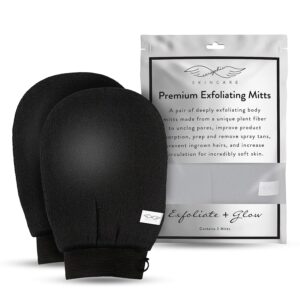Using brushes and gloves as part of your skincare routine can be helpful in managing keratosis pilaris by exfoliating the skin and improving its texture. Here are some options to consider:
- Body Brushes:
- Body brushes with natural bristles or soft synthetic bristles can be used to gently exfoliate the skin affected by keratosis pilaris. Dry brushing before showering can help remove dead skin cells, promote circulation, and reduce the buildup of keratin. Look for brushes with long handles for easier reach on your back or other hard-to-reach areas.
- Exfoliating Gloves:
- Exfoliating gloves are typically made of textured fabric or materials like nylon or polyester. These gloves can be used in the shower with your regular body wash to gently scrub and exfoliate the skin. The textured surface helps remove dead skin cells and smooth out rough patches caused by keratosis pilaris.
- Konjac Sponges:
- Konjac sponges are natural sponges made from the root of the konjac plant. They are gentle and can be used on sensitive skin. When used with water or a mild cleanser, konjac sponges provide gentle exfoliation and can help improve the appearance of keratosis pilaris.
- Silicone Body Scrubbers:
- Silicone body scrubbers have small bristles or nubs on their surface. They can be used with your regular body wash to massage and exfoliate the skin. Silicone scrubbers are generally more hygienic than traditional brushes or gloves since they are easier to clean and dry.
When using brushes, gloves, or other exfoliating tools for keratosis pilaris, it’s important to be gentle and not overly scrub or irritate the skin. Start with gentle pressure and gradually increase if needed, but avoid excessive force that could lead to skin irritation. Also, be mindful of your skin’s sensitivity and adjust the frequency of exfoliation based on how your skin responds.
Remember to moisturize your skin after exfoliating to help maintain hydration and support the skin’s barrier function. Additionally, it’s always a good idea to consult with a dermatologist to determine the most suitable exfoliation method and frequency for your specific condition.


